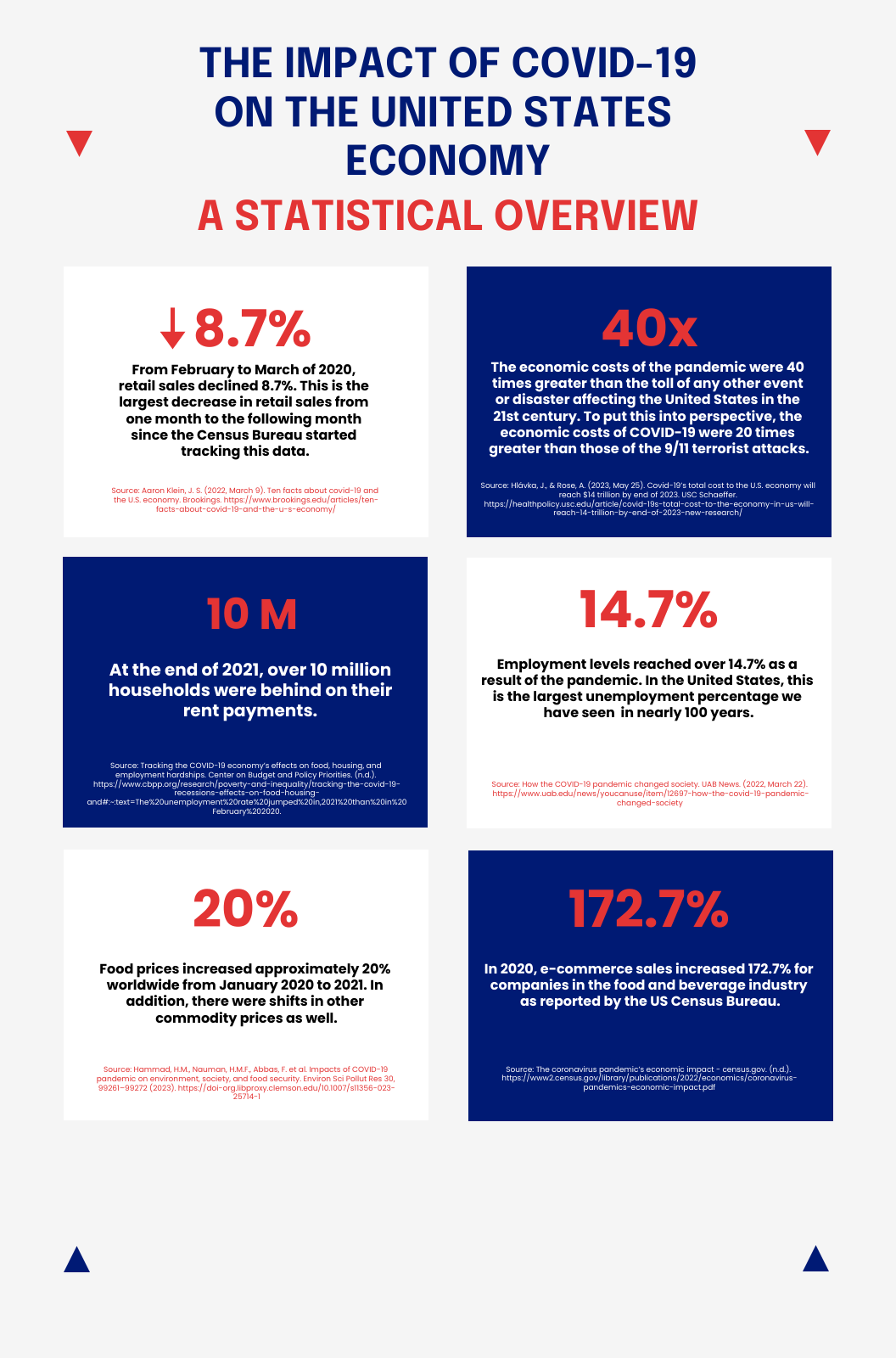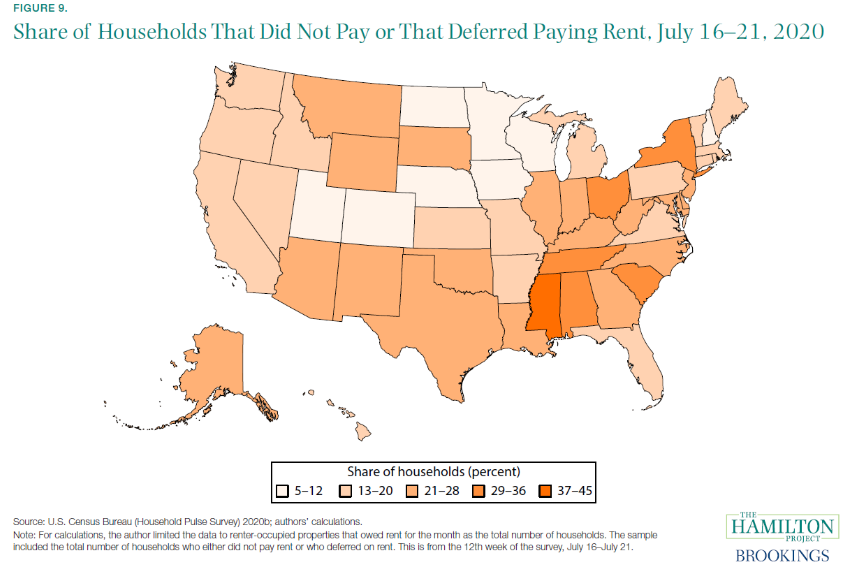COVID
110 The Effect of the Covid-19 Pandemic on the US Economy
Connor Miaskiewicz and Riley Shaw

Introduction
The Covoid-19 Pandemic delivered a simultaneous public health and economic crisis that brought unprecedented devastation to the United States. By late 2023, the cumulative economic toll of the pandemic was estimated at $14 trillion (Hlávka & Rose, 2023). The rapid onset of business closures, supply chain disruptions, labor market volatility, and shifting consumer behaviors led to a halt in economic growth, exacerbating existing inequalities. Some sectors rebounded with the help of federal relief, but the overall damage was a systemic shock to the entire US economy.
Connection to STS
The Covid-19 pandemic demonstrates how science, technology, and society are intertwined. Public health decisions, such as lockdowns and mask mandates, were scientifically based, but stirred social and economic impacts. Technology adapted, creating a shift towards remote work and increased online shopping. Simultaneously, the skewed distribution of health and economic outcomes among minority and low-income groups highlighted and exacerbated systemic inequalities. The outcomes of this crisis show how societal outcomes are dictated by policy decisions, technology and infrastructure, and existing social inequalities.
Immediate Impacts
The US economy drastically shrank in early 2020. Between fiscal Q4 2019 and Q2 2020, total GDP dropped 9.1%, the steepest decline over the same time frame on record (Bauer, et al., 2020). The estimated decrease in economic output from 2020 to 2023 was a 14% reduction than what it would have been without the pandemic. Different sectors were hit harder than others, with air travel down 57.5%, dining down 26.5%, and health and social services down 29.2%(Hlávka & Rose, 2023). While technology-enabled industries adapted quickly, industries that were dependent on in-person labor and interactions suffered long term downturns.

Figure 1. GDP Comparison By Recession (Bauer, et al., 2020)
The labor market experienced historic levels of disruption. In April 2020, 20.5 million jobs were lost in just one month (Bauer, et al., 2020). Unemployment rate skyrocketed to 15%, while underemployment was likely much higher when accounting for misclassified workers and reduced hours. Women, especially Black and Latina women, underwent greater lob loss than men due to caregiving burdens (CBPP, 2024). Unemployment among people without a bachelor’s degree fell 19.3% at the height of the Covid recession, and they felt a longer recovery time compared to higher-educated workers (CBPP, 2024).
Inequality and Overlooked Populations
The economic and resulting health outcomes after the onset of the Covid-19 Pandemic disproportionately impacted marginalized groups. Systemic inequalities in health care, housing, and employment meant that Black, Hispanic, and Native communities were more likely to encounter economic instability and negative health outcomes (Bauer, et al., 2020). Psychological distress also rose sharply. Similar economic patterns emerged in Germany with higher government debt, unemployment, and overall loneliness leading to higher rates of mental health issues, particularly in low-income females (Liu, et al., 2021). Studies in the US found similar results, where low-income families with children faced high rates of income loss and food insecurity (Bauer, et al., 2020). Women, particularly mothers, saw significant labor disruption, minority workers and business owners were more likely to face economic strain, and lower education workers faced higher job losses with less options for remote work (Piacentini, et al., 2022).

Figure 2. Job Loss Comparison (CBPP, 2024)
While federal aid and temporary relief programs helped many households through the worst months of the pandemic, some communities were left behind in the recovery process (CBPP, 2024). Federal relief efforts unintentionally led to high levels of inflation due to the economy rubberbanding, impacting low-income groups. Immigrants faced barriers to aid worsening their economic situation. Additionally, people who are dealing with long-term health impacts of Covid are experiencing difficulty maintaining employment due to their worsened health (CBPP, 2024). Prolonged economic instability in low-income and minority groups reveals a layer of harm caused by the pandemic recession that goes beyond the GDP and unemployment statistics. Acknowledging these groups is essential when attempting to address long-term economic impacts of Covid-19.
Recovery and Long-Term Costs
Recovery from the pandemic recession was faster than many economists predicted, largely due to unprecedented levels of fiscal stimulus and government spending. The CARES Act and the American Rescue Plan were essential to stabilizing households and businesses (Bauer, et al., 2020). The National Bureau of Economic Research declared the pandemic recession to be the shortest on record, lasting only two months (CBPP, 2024). Real GDP surpassed pre-pandemic levels by mid-2021, and payroll employment exceeded February 2020 levels by December 2023.
Despite this overall recovery, the long-term economic damage remains substantial. According to the Census Bureau, small business saw revenues fall by over 20%, and many never reopened (Roman et al., 2022). Food insecurity doubled among households with children between 2018 and 2020, disproportionately affecting Black and Hispanic families, and the pandemic impacted families ability to recover from this (Bauer, et al., 2020). The Brookings Institution estimated that 420,000 small businesses closed permanently in 2020 alone, leaving millions without a means to make a living.
Additionally, the pandemic prompted a spike in personal savings during the lockdown. This was felt unevenly, with low-income households remaining vulnerable, despite stimulus checks (Bauer, et al., 2020). This was exacerbated by a lack of access to unemployment insurance. Housing insecurity and an inability to pay rent also surged, with more than 20% of households in 26 states falling behind on rent in mid-2020 (Bauer, et al., 2020).

Figure 3. Map of Rent Deferrals during July 16-21, 2020 (Bauer, et al., 2020)
While recovery efforts succeeded in many ways, they were limited by systemic inequalities of the US economy. As we move forward, the disruptions to education, long-term unemployment for certain demographics, and health care impacts may persist into the next decade.
Conclusion
The Covid-19 pandemic reshaped the US economy in both visible and subtle ways. It exposed vulnerabilities in labor markets, deepened systemic inequalities, and disrupted the flow of economic activity, especially industries that could not adapt. Sectors that recovered quickly were able to keep up with the accelerated movement towards a digital workplace. The pandemic also emphasized the role of public policy in mitigating large-scale crises. Understanding the pandemic through an STS lens highlights how science, policy, technology, and social systems evolve together during difficult times. As the US moves forward, lessons learned from this time period will be essential for building a more resilient and equitable economy.
| Chapter Activity |
| 1. List three major impacts that Covid-19 had on the US Economy. |
| 2. Do you think government stimulus positively or negatively impacted pandemic recovery? Did the government do enough, too much, or just the right amount of relief? |
| 3. Describe how Covid-19’s impact on the economy disproportionately affected lower income families. |
| 4. How were you or your family impacted by the Covid-19 Recession? Are those impacts lasting to this day? |
References
Bauer, L., Broady, K., Edelberg, W., & O’Donnell, J. (2020, September 17). Ten facts
about COVID-19 and the U.S. economy. BROOKINGS. https://www.brookings.edu/articles/ten-facts-about-covid-19-and-the-u-s-economy/
CBPP. (2024, April 3). Chart Book: Tracking the Recovery From the Pandemic
Recession. Center on Budget and Policy Priorities. https://www.cbpp.org/research/economy/tracking-the-recovery-from-the-pandemic-recession
Hlávka, J., & Rose, A. (2023, May 25). Covid-19’s total cost to the U.S. economy will
reach $14 trillion by end of 2023. USC Schaeffer. https://healthpolicy.usc.edu/article/covid-19s-total-cost-to-the-economy-in-us-will-reach-14-trillion-by-end-of-2023-new-research/#:~:text=The%20big%20idea,and%20other%20experts%20have%20estimated.
Liu, S., Haucke, M. N., Heinzel, S., & Heinz, A. (2021). Long-Term Impact of Economic
Downturn and Loneliness on Psychological Distress: Triple Crises of COVID-19 Pandemic. Journal of Clinical Medicine, 10(19), 4596–. https://doi.org/10.3390/jcm10194596
Piacentini, J., Frazis, H., Meyer, P. B., Shultz, M., & Sveikauskas, L. (2022, August 5).
The impact of covid-19 on labor markets and inequality. BLS WORKING PAPERS. https://www.bls.gov/osmr/research-papers/2022/pdf/ec220060.pdf
Roman, S., Cooke-Hull, S., Dunfee, M., Flaherty, M., Haskell, J., Holland, V., Jackson,
C., & Shevlin, C. (2022, July). The Coronavirus Pandemic’s Economic Impact.
Census Bureau.
https://www2.census.gov/library/publications/2022/economics/coronavirus-pande
mics-economic-impact.pdf
Figures
Bauer, L., Broady, K., Edelberg, W., & O’Donnell, J. (2020, September 17). Ten facts
about COVID-19 and the U.S. economy. BROOKINGS. https://www.brookings.edu/articles/ten-facts-about-covid-19-and-the-u-s-economy/
CBPP. (2024, April 3). Chart Book: Tracking the Recovery From the Pandemic
Recession. Center on Budget and Policy Priorities. https://www.cbpp.org/research/economy/tracking-the-recovery-from-the-pandemic-recession
AI Acknowledgment
I used ChatGPT to help me summarize and highlight the information from sources that I collected regarding The Effect of the Covid-19 Pandemic on the US Economy. It provided summaries of the content, pulling information relevant to the textbook chapter, Information that was used was validated with the original sources. (2025), ChatGPT 4o. https://chatgpt.com

